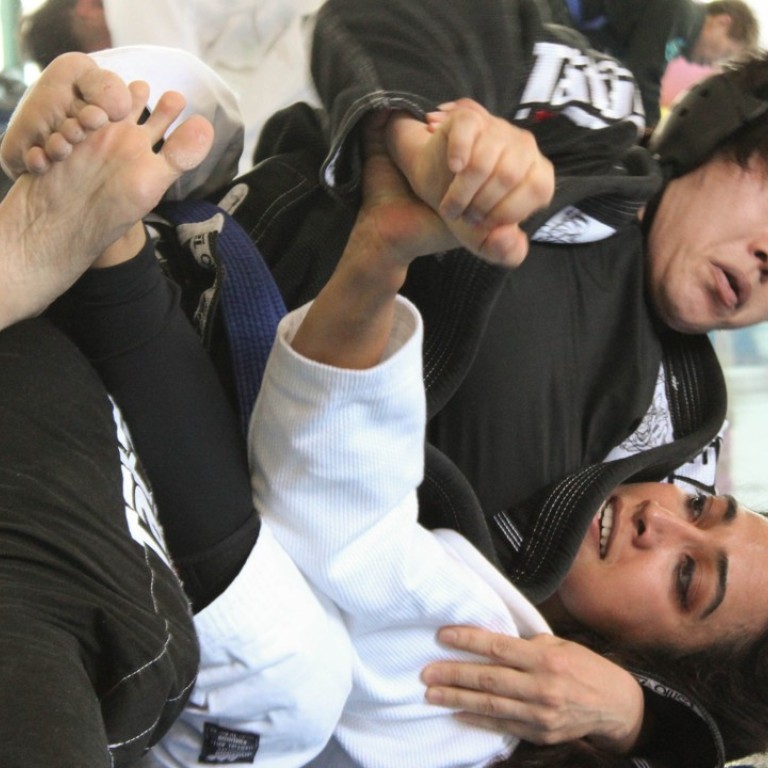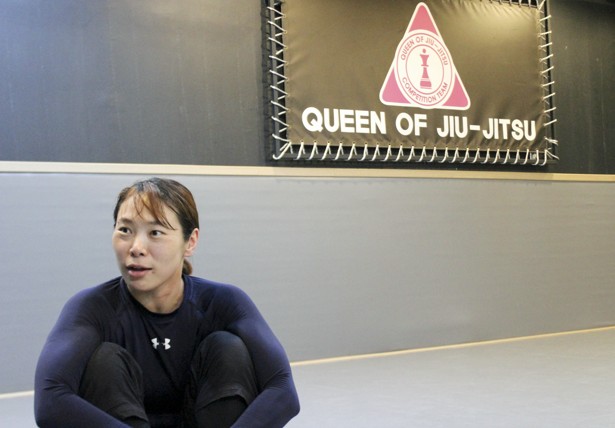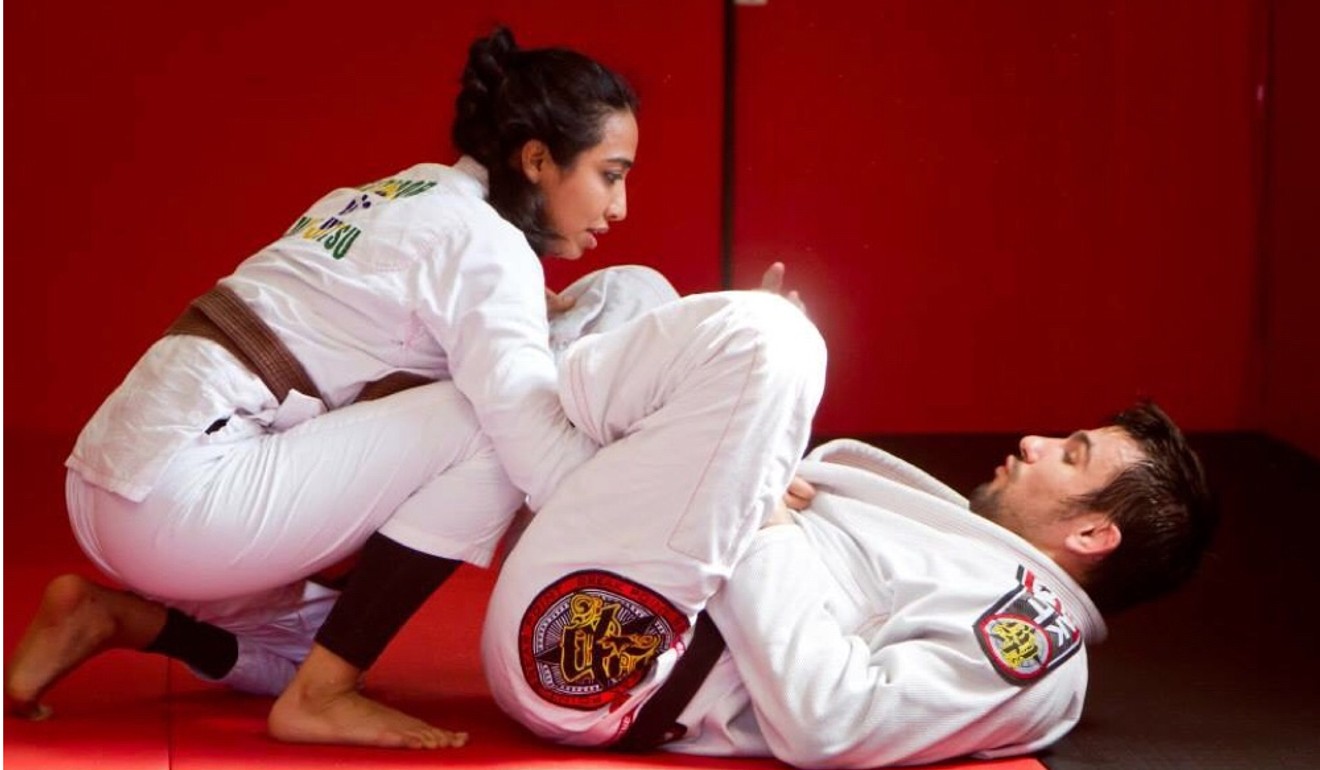
As Brazilian jiu-jitsu in South Korea grows, women are fighting as hard as men
A martial art that teaches smaller people to defend themselves against larger assailants, Brazilian jiu-jitsu is gaining popularity in the home of taekwondo – especially among women, helped by female instructors and women-only tournaments
Heejin Lee is crouched on a floor mat, demonstrating moves that could be debilitating or even life-threatening if used on someone in self-defence.
Lee, 40, was South Korea’s first woman to earn a brown belt in Brazilian jiu-jitsu. Today, she is the country’s sole female black belt, the sport’s highest ranking, and is the instructor and owner of the Queen of Jiu-Jitsu academy in Seoul.
Hong Kong goes ‘mixed martial arts’ crazy... and you don’t even have to fight
These days the evening classes in her second-floor studio are filled with students as Korean interest in the sport blossoms. Brazilian jiu-jitsu, or BJJ as it is more commonly known, is a sport, martial art and self-defence technique that centres on grappling and ground fighting. It developed from the Japanese martial art of judo, so many judo fighters cross-train.
BJJ was developed so that smaller and weaker opponents could defend themselves and take down larger, stronger assailants by applying joint locks and choke holds. As the popularity of mixed martial arts has risen, BJJ has become one of the world’s fastest growing martial arts.

The growth is perhaps surprising in a country that originated its own popular martial art, taekwondo. In January, the popular comedienne Park Na-rae demonstrated BJJ on the MBC television programme I Live Alone, a key move in a country where celebrities are trendsetters.
Fellow comedians Heo Kyung-hwan, Lee Seung-yoon and Yoon Hyung-bin also recently became BJJ fighters. Seungri from K-pop giants Big Bang has extolled BJJ’s benefits in recent Instagram posts and K-drama actor Oh Ryong from Something in the Rain appears in a BJJ feature in the June issue of Men’s Health Korea.
It’s not quite a boom, but the interest has been significant enough to attract a legion of new converts.
While some of the new students at Lee’s studio only stay enrolled long enough to snap a selfie for Instagram, many more are there for the longer haul. It’s a formidable task, given that much of BJJ’s focus is winning competitions through technique and working your way out of difficult situations – like a choke hold – while keeping a cool head.

John Frankl, a professor at Seoul’s Yonsei University, brought BJJ to Korea in 1999 while visiting from the United States for a year as a researcher. There was no local club and as a brown belt, he had no intention of abandoning his training – so he started one.
He opened the country’s first academy in 1999 and today has several studios in Korea that bear his name. Lee studied under him and with his tutelage earned her black belt in 2013, which she promptly used to open her own studio. Her photo graces a tiny wall of fame in Frankl’s studio in Gangnam.
Lee’s journey from student to instructor was strategic as she set out to develop more female competitors.
“I wanted to provide a stage where women could be the centre of attention,” Lee says as her white Pomeranian, Choke, plays near cubbies filled with shoes and socks. “It’s hard for women to get noticed with so many men competing.”
Many gyms worldwide hold regular female-only classes as, given the intense physical contact involved in the sport, a lot women aren’t comfortable practising with men. Lee, however, holds women-only seminars only once a month.
In March, she held the first women-only tournament in the country, which attracted 130 participants; she is planning a second for October. Part of her motivation is to help remove one of the biggest barriers from women advancing in competition: obtaining sponsorships.
It’s like a human chess match. There’s nothing more intimate than simulating murder with a stranger
Lee encourages all her students to compete, believing that learning to spar with different people and in myriad situations is a skill that translates outside the gym. “Even losing can be a method of developing a mindset or controlling an aggressor,” she says.
Lee came to the sport about 20 years ago after studying the eclectic Korean martial art of hapkido – which involves kicking, punching and weapons such as sticks, canes, swords, knives and ropes – but finding it impractical. “It was hard to fight with men. If I’m attacked in the street, I can’t use it.”
Brazilian jiu-jitsu levelled the playing field, she says. “It looks similar to hapkido but on the ground, it’s really different.” She set the goal of earning a black belt and opening a gym in 10 years, which she achieved.
Why you get better results from group exercise than going it alone
Nilofer Mallick moved to Seoul from New York in April. In a recent class at one of Frankl’s gyms, her bulky male opponent struggles to flip her off him despite the fact that she weighs less than 54 kilograms (120 pounds).
When Mallick moved to Seoul, she was surprised to find more women at Frankl’s gym than she had seen in gyms in the United States. Practising gave her an immediate community in a new country.
An airline pilot, she practises BJJ twice a day when she is in Seoul. She has reached brown belt, the martial art’s second highest ranking; in Korea, and is among just three or four women who have attained the honour.

An estimated 3 to 4 per cent of practitioners will make it to brown belt; fewer reach black. Achieving the dan (black belt) grade requires not only technical knowledge, but also verifiable ability in sparring.
“It’s like a human chess match,” Mallick says of the sport’s appeal. “There’s nothing more intimate than simulating murder with a stranger.”
Practising BJJ has made her a more well-rounded person, she says, and exercises her mind, body and soul.
“On the mats I’ve become exposed to such diverse backgrounds and personality types to which I might never have been exposed otherwise. With that, I have become more confident and natural when interacting in my professional life, and it has provided me the reinforced sense of self to grasp effective command authority on the flight deck.”

She adds that it has also taught her how crucial mutual respect is.
“Some of the most unassuming people I’ve seen have turned out to be some of the most badass people out there. Never judge a book by its cover and understand that every now and then, a good humbling is going to check your ego. Embrace it and grow.”
Eight tips for Brazilian jiu-jitsu newcomers
1. Join a reputable training school rather than studying alone to learn proper form and technique.
2. Choose a school that is clean and well-maintained. The sport values cleanliness. Come to the mat clean and shower afterwards. Keep your nails trimmed. As with any form of grappling, there is a risk of developing skin infections such as ringworm. If you have an infection, don’t go to the gym.
3. Stretching is often the most disliked part of the training but it’s probably the most important. Not stretching increases chance of injury.
4. Don’t wear shoes on the mat. Also avoid perfumes and strong, scented lotions.
Hate the gym? How personality type affects your exercise preferences
5. Be respectful of everyone’s journey and have patience in yours. Context matters when you’re training. “Not everyone is there for the same reason,” Mallick says. “Some see it as a way to stay active; others are competitive.”
6. When sparring, don’t go after injured body parts. If someone is injured, cut them a break. “The people that you simulate murder on are your teammates,” Mallick says. “Everyone has to go to work tomorrow. Don’t be out to hurt people.”
7. Keep a positive attitude. Everyone is learning and training each other so mistakes are expected.
8. Go as you are. “People think they need to be in shape to practice jiu-jitsu,” Mallick says. “jiu-jitsu will get you in shape. You’re going to come in not knowing. If you want to be in shape for the sport, train in the sport.”
